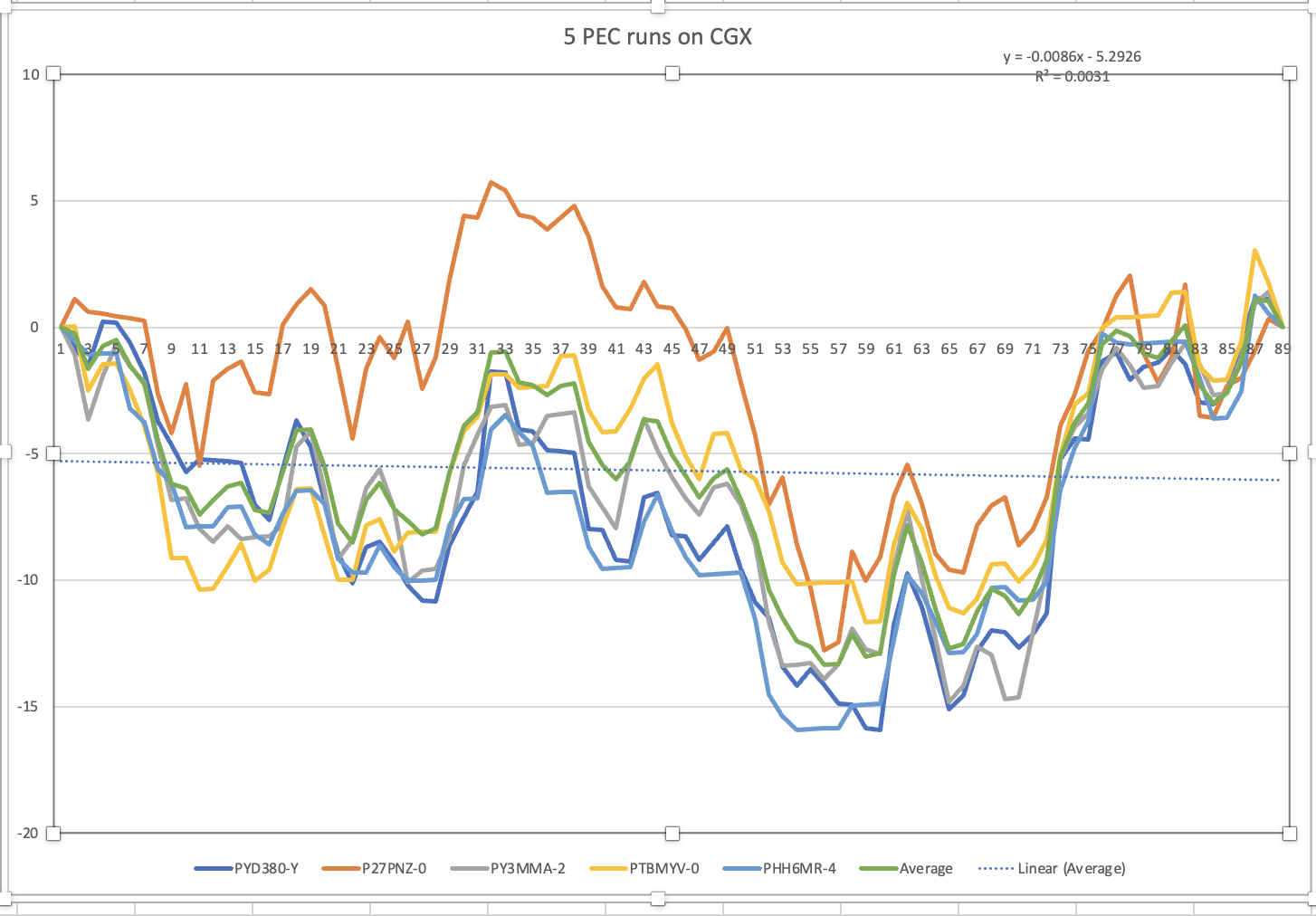INDI Library v2.0.7 is Released (01 Apr 2024)
Bi-monthly release with minor bug fixes and improvements
CGEM PEC Data Confusion
- Ronald Scotti
-
 Topic Author
Topic Author
- Offline
- Elite Member
-

- Posts: 396
- Thank you received: 17
CGEM PEC Data Confusion was created by Ronald Scotti
I am looking at the data in an excel spreadsheet and I am confused by what I see. The data cycles are all over the place, some start going negative, some start going positive; none look like a "classic" PEC curve of one cycle or even more. The only thing they have in common is that they all start at value 0 and all end at value 0 (I assume drift is removed). The excursions of the data are similar; the positive and negative peak values are about the same for each set, but they don't occur at the same point in the cycle (not even close). I had assumed that while the data is collected starting at any index, the output data (to the file) is registered to the same starting index for all the cycles (Question 1: is this correct?). If I just average all 14 cycles the resultant curve is all positive with some squiggles. I might consider flipping some curves so they all start going in the same direction, but I don't have a justification for doing this.
So, I understand that the added value of using a stored set of PEC data for the CGEM may be of marginal value, the PPEC guiding routines do a pretty good job of taking care of that. But I have also read that people have found some improvement in doing so and we are all looing for the best guiding we can achieve.
Can someone explain what the PEC collection part of the CGEM Indi control panel is doing or at least point me to where I can look at the code to try to figure that out myself. Does anyone have any experience taking PEC data using this tool and have results of using the PEC stored in the mount?
Please Log in or Create an account to join the conversation.
- Ronald Scotti
-
 Topic Author
Topic Author
- Offline
- Elite Member
-

- Posts: 396
- Thank you received: 17
Replied by Ronald Scotti on topic CGEM PEC Data Confusion
I may have to are-runthe experiment using a different Phd2 algorithm as the Celestron PEC collection is expecting you to be manually guiding the mount (assuming the PEC routine has not been updated since the manual was written!). Is there anyone with better information?
thanks,
Please Log in or Create an account to join the conversation.
- Jerry Black
-

- Offline
- Elite Member
-

- Posts: 460
- Thank you received: 69
Replied by Jerry Black on topic CGEM PEC Data Confusion
Please Log in or Create an account to join the conversation.
- Ronald Scotti
-
 Topic Author
Topic Author
- Offline
- Elite Member
-

- Posts: 396
- Thank you received: 17
Replied by Ronald Scotti on topic CGEM PEC Data Confusion
I did just that tonight. I had fairly good seeing, started out in PPEC, but then switched to the Hysterisis algorithm and let that guide while I recorded PEC data at the mount (guiding was not too different from when I used PPEC, it can give a total RMS around 1"/px, with Hysterisis I was getting around 1.4"/px). I use the routine built into the Indi control panel for the Celestron CGEM mount. I recorded 6 cycles, each starting at different index values. I have not had a chance to review all 6 sets of data, but from what I did look at I am still seeing that they don't appear to be in phase. I wish someone would confirm for me that the data stored in the file in the Pec_Data folder is actually ordered from index 0 to 88, rather than in the order the data was taken (I don't always start at index 0 as the index continues to increase and I start one set after I have recorded/saved the previous set, so there is an offset in the index value between saved sets). As someone has suggested maybe I am just wasting good imaging time and should just guide with PPEC and not worry about putting a PEC curve into the mount, but I am stubborn.
Please, let me know how you make out. I would love to have some verification that what I am trying will work.
thanks,
Please Log in or Create an account to join the conversation.
- Jerry Black
-

- Offline
- Elite Member
-

- Posts: 460
- Thank you received: 69
Replied by Jerry Black on topic CGEM PEC Data Confusion
Attachments:
Please Log in or Create an account to join the conversation.
- Ronald Scotti
-
 Topic Author
Topic Author
- Offline
- Elite Member
-

- Posts: 396
- Thank you received: 17
Replied by Ronald Scotti on topic CGEM PEC Data Confusion
I am running Kstars/Ekos on a Rpi with Ubuntu OS, so I cannot run some other outside programs to record PEC data. In the Indi Control panel for the mount there is a section for recording and playing back PEC. last night I started guiding using Hysteresis in Phd2, after I found the current mount index. The first run the index was at (50) and I let it record and save to a file. I did the same for the next 5, however I could not always start them at the same index, so my data started at different Index values; they are: 50 - 0 - 3 - 14 -15 - 0. From my data you can see that run 2 and 6 look the most alike (both started on index 0). While series 4 and 5 (both around index 14) look like flipped versions of each other (I have read that can happen). I had looked at the CGEM Indi program on Github and it looked to me like the data was always printed out from index 0 to 88, but maybe that was just the order of collection and not the actual index value that the data recording started. In other words the data was not re-arranged to produce a listing always starting at index 0, instead it is just recorded from 0 to 88 values starting at whatever index value you clicked record on. At least that is what I think based on the data I collected using the Indi Control Panel for the Mount in Kstar/Ekos.
How did you collect your data, were you careful to make sure each run started on index 0, or are you using the PECTool outside of Kstars/Ekos where it can record multiple PEC cycles?
I did not want to wait another 8 minutes between PEC records to make sure they started at the same index value, but it looks like I may have to in order to get good PEC data. I am going to 'play' with my data to see if I can shift the other sets of data into something that looks like cycles 2 and 6.
thanks for following up on this.
Attachments:
Please Log in or Create an account to join the conversation.
- Jerry Black
-

- Offline
- Elite Member
-

- Posts: 460
- Thank you received: 69
Replied by Jerry Black on topic CGEM PEC Data Confusion
Please Log in or Create an account to join the conversation.
- Ronald Scotti
-
 Topic Author
Topic Author
- Offline
- Elite Member
-

- Posts: 396
- Thank you received: 17
Replied by Ronald Scotti on topic CGEM PEC Data Confusion
I did take my two '0' index curves, averaged them and used PECPrep to smooth the curve as I have read that you could introduce spurious frequencies into the guiding if the data is too jagged. I am not sure how much of an issue that is really, but it was fairly easy to smooth the data.
After averaging, my PEC curve would look like this.
Of course what gets loaded up is just the list of 88 points, this is just a plot of those points. The only real test is to upload the data into the mount and see if your guiding improves with the PEC data enabled over that without it.
thanks,
Attachments:
Please Log in or Create an account to join the conversation.
- Ronald Scotti
-
 Topic Author
Topic Author
- Offline
- Elite Member
-

- Posts: 396
- Thank you received: 17
Replied by Ronald Scotti on topic CGEM PEC Data Confusion
I guess the good news of this thread is that I should be able to collect PEC data anytime I am guiding while imaging, the bad news is that I may just end up with many more randomly phased PEC curves.
Please Log in or Create an account to join the conversation.
- Jerry Black
-

- Offline
- Elite Member
-

- Posts: 460
- Thank you received: 69
Replied by Jerry Black on topic CGEM PEC Data Confusion
Where did you find the note about spurious frequencies?
Cheers
Please Log in or Create an account to join the conversation.
- Ronald Scotti
-
 Topic Author
Topic Author
- Offline
- Elite Member
-

- Posts: 396
- Thank you received: 17
Replied by Ronald Scotti on topic CGEM PEC Data Confusion
Your mount is likely totally different as it is 'belt' driven and probably avoids a lot of this issue. I hypertuned my mount myself, with a kit, and I have swapped gears in the motor gear box to try and find the smoothest gears for the RA axis (as DEC guides fine in one direction) . It is a never ending saga until you finally say; I give up and just guide the best you can with Phd and do some imaging. My solution was to purchase a Starizana .63 x reducer and use my SCT 9.25 at f6.3 instead of f/10. And in fact I have ordered, when available, their NightOwl reducer, which takes the scope to f/4 and should make guiding much less important as I can image much faster.
But as I mentioned the only way to 'know' if your PEC is working is to run Phd2 with and without PEC enabled and look at the results.
Please Log in or Create an account to join the conversation.
- Ronald Scotti
-
 Topic Author
Topic Author
- Offline
- Elite Member
-

- Posts: 396
- Thank you received: 17
Replied by Ronald Scotti on topic CGEM PEC Data Confusion
Cloudy Nights PEC on CGEM thread
thanks,
Ron
Please Log in or Create an account to join the conversation.



